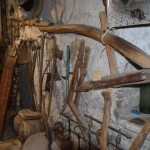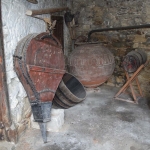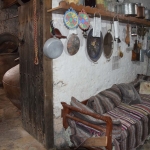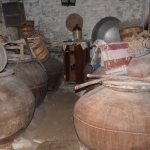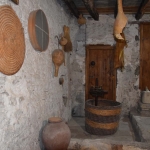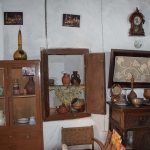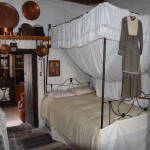Struggle Museum
The national liberation struggle of Cyprus against the British colonial administration, known as the EOKA struggle, started on the 1st of April 1955 and ended with the Zurich — London agreements in February of 1959.
The Struggle of EOKA is the culmination of long-standing struggles on behalf of the People of Cyprus in order to conquer their freedom.
Omodos was always present in all of the struggles for the freedom of Cyprus. Its contribution dates back to the first quarter of the previous century.
With Church Steward Dositheos, from the Holy Monastery of the Holy Cross in Omodos, as the head figure, the inhabitants actively participated in the Greek revolution. Omodos’s inhabitants also actively participated in the two World Wars, as well as in the national liberation struggle of EOKA 1955 — 1959.
The contribution of Omodos was great and the price that was paid was heavy. Arrests, imprisonment, the blowing up of a hide-out, and other catastrophes.
After the end of the struggle, on the 28th of October 1960, a group of inhabitants had the concept for the creation of a National Struggle Museum in Omodos, so as to present to the younger ones the contribution of Omodos to the national struggles. A hall of the Monastery was used for the housing of the Museum.
The Committee consisted of: Giorgos Papadopoulos, Ioannis Sokratous, Polykarpos Perdikis, Christakis Antoniou, Georgios Tzivitanidis, Fofo Nikolaidou, and Andreas Stylianidis.
After an initiative on their behalf, material was gathered from all the families -throughout Cyprus -of the fighters that fell in combat, that is, personal items, uniforms, documents, photographs of the EOKA heroes, etc.
And so the first National Struggle in Cyprus was created.
In July 199 the Museums was re-formed and re-housed in another hall of the Monastery, the expenses paid by the Historical Memory Council for the EOKA Struggle 1955 — 1959 and the -at that time -Church Committee of the Holy Cross Church in Omodos (Church Steward Constantinos, Panikos Socratous, Georgios Panagiotou, Herodotos Eftymiou, and Ioannis Avraamidis).
Such material belonged to the following fighters that fell in combat:
| 1.Afxentiou Grigoris | Lysi |
| 2. Anastasi Dimitrakis | Lysi |
| 3. Kaili Michail | Lysi |
| 4. Siakka Kallis | Lysi |
| 5. Panagidis Christofis | Lysi |
| 6. Souroullas Anastasios | Lysi |
| 7. Georgiou Georgios | Lysi |
| 8. Drakos Markos | Nicosia |
| 9. Pallikaridis Evagoras | Tsada |
| 10. Lenas Stylianos | Chandria |
| 11. Pittas Fytis | Frenaros |
| 12. Papageorgiou Loukia | Avgorou |
| 13. Karyos Andreas | Avgorou |
| 14. Michail Charilaos | Galini |
| 15. Zakos Andreas | Linou |
| 16. Mavrommatis Stelios | Lapithou in Larnaca |
| 17. Koutsoftas Michail | Paliometocho |
| 18. Hadjitheodosiou Theodosis | Stylloi in Ammochostos |
| 19. Stylianou Miltiadis | Tala |
| 20. Michail georgios | Kissonerga |
| 21. Toumazou Panagiotis | Ammochostos |
| 22. Karaolis Michalakis | Palaichori |
| 23. Dimitriou Andreas | Agios Mamas |
| 24. Loizou Kostas | Marathovounos |
| 25. Kannaouris Christodoulos | Kyperounta |
| 26. Paridis Michalakis | Anafotia |
| 27. Herodotou Dimos | Dora |
| 28. Giagkou Nikolas | Zodia |
| 29. Tsiartas Christos | Polystypos |
| 30. Christodoulos Dimitrios | Deryneia |
| 31. Charalampos Aristeidis | Pedoulas |
| 32. Constantinou Alekos | Kakopetria |
| 33. Papachristoforou Evagoras | Kato Amiantos |
| 34. Panagiotu Andreas | Polystypos |
Editing of text: Panayiotis Socratous
Secretary of ecclesiastical committee
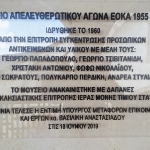
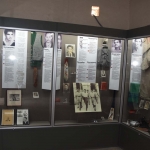
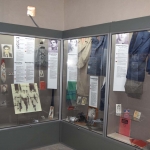
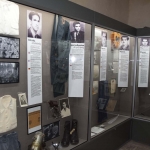

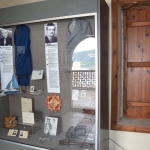
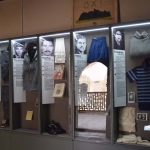
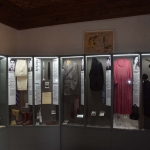
The Iconostasis of the holy Monastery of Timios Stavros Omodos
The Ecclesiastical Museum is expected to start operating soon. Like all museums, it will be housed in two renovated halls with arches, which lie at the floor below the monastery’s complex.
The museum will house a great number of remarkable items and valuable treasures of Orthodoxy, which were saved by earlier generations who in turn passed them on to their descendants.
All these artworks will be exhibited in a specially designed place in the halls and will be presented to the public. This exhibition will contribute significantly to their protection and conservation.
Some of the remarkable items to be exhibited are the following:
- Byzantine icons of excellent craft
- Ancient gospels of 1769 and 1728
- Old books, some belonging to monthly editions, from the 16th-19th century. Some old editions include hand-written reminders which are very old
- The golden-embroidered, big Russian Sepulchral
- Big, wooden, graven gilded lamps and stands for the gospels
- Excellently crafted communion cups and other holly vessels like grippers used in the Holly Communion
- Ancient holly canonicals, belt fasteners and clerical belts
- Silver reliquaries etc
Panagiotis Socratous
Secretary of the Ecclesiastical Committee
Church of Holly Cross of Omodos
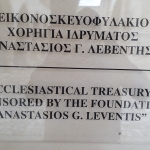

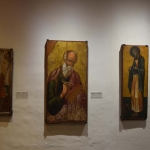


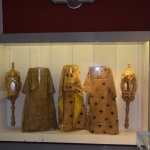

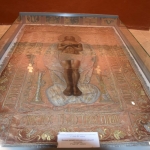
Folklore Museum
One of the recent acquisitions of Omodos’s community is the picture Gallery. It is the creation of a permanent collection of Art Works by modern Cypriot painters that have Omodos as their subject. In it are kept the paintings of landscapes in Omodos, inspired by the village.
They are housed in a hall of the Monastery that used to serve -in previous times -as a cell for monks. The establishment of the Picture Gallery started in 1986 with works of Cypriot painters, which were inspired by the natural and human environment of Omodos. Already, there are more than 40 note-worthy paintings and etchings in the Gallery that were offered (free of charge) by their makers -known Cypriot Artists.
The “Friends of Omodos” Club and the Community of Omodos have -from time to time -been hosts to members of the chamber of Fine Arts (EKATE), who organised an art symposium in the context of the “ΛΗΝΑΙΑ” (pronounced Lee-ne-a), the four-day celebratory events and exhibitions that are conducted in August every year.
Known Cypriot painters attended these symposiums:
- Rotsidou – Jones Thrakis
- Spyros Dimitriadis
- Nitsa Hadjigeorgiou
- Champis the Etching Artist
- Aristotelis Dimitriou
- Kypros Kyprianou
- Andreas Kleovoulou
- Andy Partzilis
- Evanthia Kouma
- Andreas Makariou
- A. Leca
- A. Erotokritou
- Rinos Stefani
- Paris Metaxas
All the paintings are note-worthy and depict historical and traditional landscapes of the village’s folkloric neighbourhoods, the renowned Monastery, the plaza, the narrow and picturesque streets, scenes of agricultural chores in the vines, and even characteristic portraits of the people of labour and exertion.
Editing of text: Panayiotis Socratous
Secretary of ecclesiastical committee
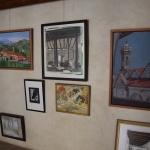
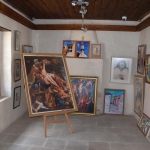



Centre for the Preservation of Narrow-knit lacing
The idea for the creation of the Centre belongs to the Cyprus Handicraft Services of the Ministry of Commerce, Industry, and Tourism. The Service, in collaboration with the Church Committee and the Community Council of Omodos, tracked down, studied, and recorded the way of making the narrow-knit lace and organised a Centre for the Preservation of Omodos’s narrow-knit lace (“pipila”).
The importance of founding the Centre is great. It is a part of a remarkable collection of lace specimens and aims to preserve traditional folkloric art / craft, the making of lace, and our cultural and historical heritage and to promote to the young -especially the young women – the contribution of Omodos’s women to the development of this type of home-made handicraft.
It is not only a traditional craft, passed from mother to daughter and from grandmother to granddaughter, it is also a kind of artistic sensitivity of the cultural tradition, a style that is deeply rooted in the souls of Omodos’s women.
Today, the -newly formed -Centre for the Preservation of narrow-knit lacing is housed in an oblong room of the Monastery’s north wing, which was previously used a cell for the monks. Its operation started some time ago, both locals and foreigners being able to visit it and admire the famous narrow-knit laces.
Some remarkable items of narrow-knit lacing are kept in the Centre, more than a hundred of them, which are only a part of the rich collection of specimens that the woman of Omodos has, intending to give them to her children and grandchildren.
The contribution of the country women of Omodos
The woman of Omodos received the Centre’s creation and the news about it with great love, eagerness, and pride; most of these women (the so-called “pipillarenes”) offered part of their creation, which they took out of their cabinets where they kept them so as to give to their children as marriage portion, either for free or as a loan. Each of them offered different designs and sizes so that the showroom would be more beautiful and exuberant.
Surely, the countrywomen of Omodos are praiseworthy and deserve warm-hearted congratulations for their vivid interest and the love that they showed for the creation of the “Centre for the Preservation of narrow-knit lacing”. The housewives of Omodos, apart from housekeeping and the hard work they offer -next to their husbands -in the vines, spend their free time making the handmade “pipila”. So, when one is visiting Omodos, that one will observe the village’s women -formerly both young and old, now mostly the old ones – gathering, where there is sunshine during the winter and in the most shadowy part of the neighbourhood in the summer, with a needle in one hand so as to make the renowned, traditional narrow-knit lace.
In this way they contribute to the improvement and completion of the country family’s needlework, offering their beautiful, handmade, embroideries to the visitors. Even today several women, more than 60 of them, use the artistry that characterises them and their industriousness, and -I believe -will continue to make these one-of-a-kind works of folkloric art in the future. However, we invite today’s generation -especially the young women -to start learning how to make the narrow-knit lace that the older generations created and bequeathed to them.
This is why training young women is of the outmost importance. Our European course, the challenges of our times, and the necessity of harmonising the countrywoman of Cyprus with the Common Agricultural Policy make the intensive preservation and revival of folkloric tradition and art necessary. Such training takes place through the programs of Cyprus Handicraft Services (of the Ministry of Commerce, Industry, and Tourism) and of the Agricultural Home Economics (Department of Agriculture). At the same time, it is believed that the research of Omodos’s lacing -and of Cyprus’s lace in general -must begin being done by expert researchers and historians, becoming a part of a wider research on the recent material civilisation. Only then we can move forward, if we return to our homeland’s tradition and experience its genuine characteristics.
Editing of text: Panayiotis Socratous
Secretary of ecclesiastical committee
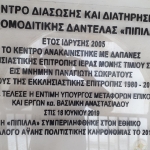
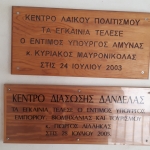
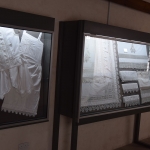
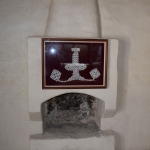
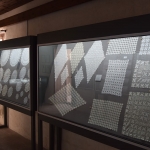
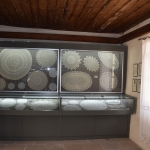
Private Museum
Private Museums exist and are maintained in Omodos, some of them being 100 year old houses, that until today are kept the same as when they were first built. These old houses themselves are of considerable interest from an architectural point of view, both externally and internally. The Private Museums are specimens of a traditional house in Omodos. They are made of stone and clay with huge, thick walls, wooden doors and tiled roofs, and flower-ridden gardens.
In the same areas that people sleep in, there were earthenware jars with wine and -many times -animals also lived there. Signs of harsh times of poverty and deprivation.
So, foreign and local tourists come up against the higher bed with the in-wrought “sklouveri” (silky mosquito net), the “amousia” (similar), the “pitsilia” (pleaded band around a bed), the wood-cut couches, the chairs made of straw fibre, the walls decorated with framed paintings made out of silkworm cocoons, family photographs, prehistoric objects, swords that have been in the family, etc. One also finds the stove and the cooking pots made of copper, the “tsestos” (shallow hamper made of wicker), the “tatsia” (very fine sieve), the “sini” (round, metal oven tray), the “zygi” (scales), the “chartzi” (copper cooking pot), the dipper, the iron ladle, the sieve, the “sisamiko” (fine sieve) and the “tamboutsia” (large, flat, leather pannier for collecting sifted wheat), the “koumni” (small, wide-mouthed pitcher) and the “kourelos” (wide-mouthed, amphora-like, earthenware pot), the frying pan and the “satzin” (iron pan with two handles), the launder and the kneading trough, the mortar and the scraper, the “tsouka” (kind of pot), and the iron-mill .
Moreover, in the house’s storage area, which -to begin with -is also a kind of “workroom” where the grapes are, many agricultural tools are kept and exhibited, most of them still being used today.
These tolls are the result of a long-standing practical need and the invention of the human mind. They are a specimen of our folkloric cultural heritage and the ingenuity of the region’s viticulturists.
The huge, earthenware jars with their covers, in which the grapes were ground and wine was made, have a special place. The “dhani” (earthen jar for racking off wine), in which they placed “zivania” (strong, transparent, alcoholic drink) or the grapes were stepped on and their juice was extracted. The grinder for the grinding of grapes. The mill for the crushing of the ground grapes. The “kouzes” (kind of pitcher), the “kolotzi” (tarred gourd) and the “koloka” (bottle-gourd), the “spilastiri” for the mixing of the grape husks, the “asiin” (goatskin) for carrying wine and vinegar. The baskets and the panniers for the gathering and carrying of the grapes.
Sometimes in the yard and other times in the house, there was the traditional caldron with which the distillation of “zivania” (raki). The tools, related to the planting and the cultivation of the grapevine, were placed in a salient spot. Such are: The plough with which they tilled the vines, the pruning hook for the pruning of the vine, the small hand-saw, the pickaxe and the “ksinari” (kind of pickaxe), the ladder for the planting of the vine, the sulpharation tin-can, the “stratouri” (pack-saddle for donkeys), the “katsounes” (plural, crooked sticks), the “fountes” (plural, thick rope for fastening hampers on animals), the “resieme” (halter), the “vourka” (shepherd’s leather bag), the “doukani” for the threshing of wheat, and others.
Editing of text: Panayiotis Socratous
Secretary of ecclesiastical committee
